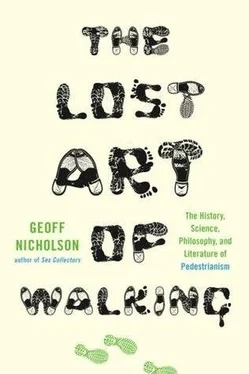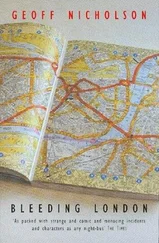If Crompton and Thorpe are correct, this information completely changes the way anthropologists are going to have to think about human development. It means, above all, that our ancestors didn’t start walking upright approximately five million years ago, as previously thought, but more like ten or fifteen million years earlier. It also means that the precise ‘reasons’ for bipedalism remain as obscure as ever.
I wasn’t much cheered by all this theory. If my ancestors had been walking for fifteen to twenty million years, that really ought to be enough time to get the hang of it, to build the skill set into the race memory.
Things only got worse when I spoke to Dr. Martin Bax, an English pediatrician with an international reputation. Martin reckoned there was nothing difficult about walking. For instance, he told me, you can see the legs of unborn babies moving in the womb, making walking motions, from about seventeen weeks. This is a good sign and proof that the baby is healthy, mobile, and not tangled up in anything, but there’s nothing very advanced about it: at seventeen weeks, the baby’s cortex isn’t fully formed, indicating that walking is a function of the spine or midbrain.
In the 1920 sand ‘30 sin Oxford, Martin said, an academic by the name of Sherington did experiments with decorticated cats. He removed their brains and found they were still able to walk perfectly well. Martin was also aware of some unpublished research done in England in the 1970 son aborted fetuses, and scientists had managed to get them walking, too. In other words, walking could be, quite literally, a brainless activity. You didn’t even have to be alive to do it.
Once babies are out of the womb, Martin continued, they achieve ‘primary walking’ at about six weeks of age. This isn’t real walking because the babies have no sense of balance and no strength in their legs, so they can’t stand up, but if you support them, they’re able to make all the motions that are needed for walking. There are some extraordinary films and photographs, shot in the late 1920 sby the German pediatrician Albrecht Peiper, in which given a certain kind of support, not only do babies walk on the ground, they can also walk up walls and on the ceiling.
In fact, there’s a long artistic tradition of walking on the ceiling, often done by stage magicians. Ricky Jay writes about them in his Journal of Anomalies . Usually there’s nothing very magical about the process. The illusion is created using suction cups, hidden ropes, or metal shoes that fit into grooves on the ceiling of a stage set.
More impressively, the Moscow Circus, in the 1960 s, featured an act in which an acrobat walked upside down along the underside of a beam that was suspended above a cage full of tigers. Simultaneously, a tiger walked, upright, across the top of the beam. As the tiger walked, it triggered a series of hidden loops that dropped down from the underside of the beam: the upside-down acrobat then inserted his feet into the loops and walked along, too. This is an amazing feat not only of walking but also of coordination. The acrobat’s steps had to match precisely those of the tiger.
A man might be forgiven for losing his footing in such circumstances, but what excuse did I have? If I couldn’t even walk in the street without falling down and breaking my arm in three places, then I had to ask myself what my qualifications were for considering myself a walker.
The overriding one was that I liked walking: I liked it a lot. And I didn’t just like it in the abstract, I liked doing it, and all through my life I’d always done it a lot, usually in an unorganized but nevertheless enthusiastic way, on four continents, at home and abroad, in town and country, in conditions that could be favorable or adverse.
Walking had certainly always been a pleasure, but it was more than that. For me walking has to do with exploration, a way of accommodating myself, of feeling at home. When I find myself in a new place I explore it on foot. It’s the way I get to know that place. Maybe it’s a way of marking territory, of beating the bounds. Setting foot in a street makes it yours in a way that driving down it never does.
Often I’ve walked for the simplest reasons, sometimes because I’ve had no choice. When I was younger and poorer, a three-mile walk home was the way I frequently rounded off an evening out. Sometimes walking is simply the most efficient way of getting from A to B. If you live in a big city, and for large chunks of my life I’ve lived in London and New York, walking is often infinitely preferable to using public transportation. When you walk you’re your own boss.
On a very small number of occasions I’ve walked as an act of political protest, though I suspect my fellow protesters might have said they were on a ‘march’ rather than a walk. These events pertained to the usual sorts of things — nuclear proliferation, the British poll tax, the ‘gate hours’ at my old college, which prevented you from having girls in your room overnight. Actually the second and third of these protests might be thought to have been successful: both the poll tax and my college’s gate hours were duly abandoned. The nuclear issue is evidently going to require a bit more walking.
I’ve also walked for charity, but that was some time ago, and even back then it struck me as a dubious thing to do. If people want to give money to charity, if they want to help fund a cure for AIDS or cancer or whatever, they should go right ahead and do it. They shouldn’t have to wait for somebody else to promise to walk thirty miles and then sponsor them to do it. It suggests that walking is some eccentric and out-of-the ordinary activity, so rare that people would only do it for money, even if the money was going to a good cause. There’s also the sense that walking is a form of suffering: by walking we share the pain and sorrow of the AIDS sufferer or the cancer patient. I object to both these propositions. Walking is special but it’s not strange. It’s not a stunt. It’s worth doing for its own sake.
There is, of course, an environmental argument in favor of walking. Undoubtedly there would be green benefits if we all walked to work rather than drove there in our cars. Undoubtedly, also, we’d do less harm if we spent our leisure hours walking in quiet places rather than, say, off-roading in SUVs. However, the changes that would be needed to convert us into a nation of walkers rather than car users are so colossal that it seems to me we’re not talking about promoting pedestrianism here, but rather about attempting to change human nature itself, which strikes me as, at best, an overambitious project. Yes, there was a time when everybody walked: they did it because they had no choice. The moment they had a choice, they chose not to do it.
If the pedestrian-advocate movement has a solution to this problem, I’ve yet to hear it. But the main problem I have with the activist walking lobby is that its members seek to make a hard and fast division between walkers and drivers: walkers are saints, drivers are pure evil. This doesn’t match my experience of humanity. Most of us are both walkers and drivers. Sure, I find drivers annoying when I walk, but I also find pedestrians annoying when I drive. It’s not clear to me that absolute virtue resides on either side.
More than that, even the most environmentally conscious walkers sometimes get in their cars and drive considerable distances in order to go walking. I can see the obvious contradiction in this, but I don’t find it genuinely pernicious. Sometimes the neighborhood just isn’t enough. In any case, my walking isn’t intended to save the planet.
Great claims are also made for the health benefits of walking, for its capacity to make us lean and fit, but I have serious doubts about this. Clearly walking is better than nothing, and in general it does the body no harm (unless you happen to pull, sprain, twist, or break something, or get run down by a car). But the number of calories burned while walking is really unimpressive. A 180-pound man walking at four miles an hour burns up about 100 calories per mile. True, a 300-pound man walking at five miles an hour burns 218 calories per mile, but I suspect there are rather few 300-pound men who are capable of walking at five miles per hour even for brief periods.
Читать дальше












